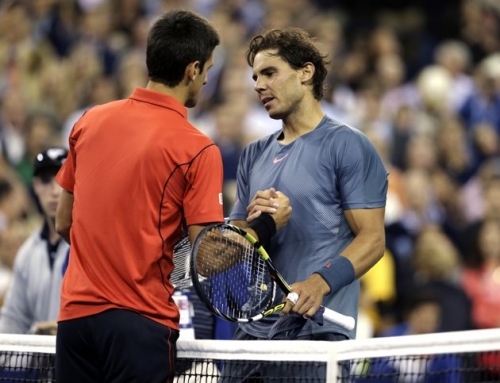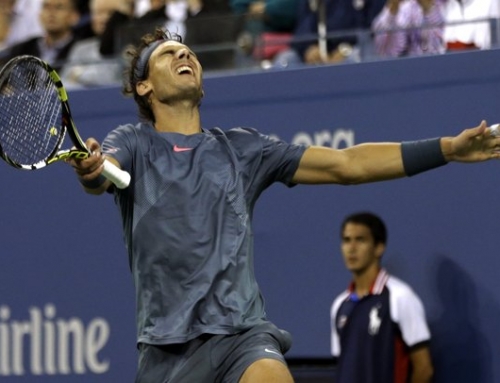 Where was this guy? For a few years, Nalbandian had been somewhat irrelevant. Sure, he was like Hewitt or Safin, the guys that came on tour when Federer did and gave Fed his share of trouble. Unlike Hewitt or Safin, who each won a pair of Slams, Nalbandian’s best efforts came in 2002 when he reached the finals of Wimbledon and met Hewitt who won one of his pair of Slams. Since then, Nalbandian has reached the semifinals of four more Slams, including 2 in 2006, but since then, he’s not even reached the quarterfinals.
Where was this guy? For a few years, Nalbandian had been somewhat irrelevant. Sure, he was like Hewitt or Safin, the guys that came on tour when Federer did and gave Fed his share of trouble. Unlike Hewitt or Safin, who each won a pair of Slams, Nalbandian’s best efforts came in 2002 when he reached the finals of Wimbledon and met Hewitt who won one of his pair of Slams. Since then, Nalbandian has reached the semifinals of four more Slams, including 2 in 2006, but since then, he’s not even reached the quarterfinals.
Nalbandian had been injured, but reserved himself for Davis Cup play. He has had to fill in because Juan Martin del Potro, the guy expected to do the heavy lifting, has been out since Indian Wells recovering from wrist injury. Apparently, del Potro has only just now started to practice again. Presumably, he’s been doing fitness and mobility work in the meanwhile.
Davis Cup has meant so much to Nalby that he skipped Wimbledon to prepare. The match was held in Russia shortly after Wimbledon. In a way, he was fortunate. Nikolay Davydenko, who was one of the hottest players on tour during the Australian Open, found out he had a broken hand/wrist (presumably his left hand) and had to skip the French Open. He played shortly before Wimbledon, but has not played particularly well since returning on tour. Indeed, after his loss to Nalbadian, Davydenko threatened to pull out of the reverse singles and had to be prodded from his wife to play (he won that match). It was up to Nalbandian to win the fifth rubber against Mikhail Youzhny, a guy that had had a pretty good six to nine months. It was a fairly clean win for Nalbandian.
Nalbandian came into Washington DC with few expectations, but he left a winner, quite impressive considering the last match that Nalbandian played prior to Davis Cup was Monte Carlo. He even did respectably well reaching the quarterfinals before losing to Djokovic, then didn’t play the rest of the clay season and skipped both the French Open and Wimbledon.
Perhaps Nalbandian’s most surprising win was over Marin Cilic which he won 6-2, 6-2. To be fair, Cilic has not had a good year following the Australian Open where he beat del Potro and reached the semifinals. Cilic has already lost early at Toronto. Even so, Cilic should have posed more of a challenge, and he didn’t. Nalbandian won DC by beating Marcos Baghdatis.
It would be easy for a player like that to come to Toronto and lose early. You see it all the time. Player wins tournament, then loses early in the next tournament, lacking either the stamina or will to want to push themselves to a second win. It happened to Sam Querrey who won LA and lost in DC (and in Toronto).
However, Nalbandian has continued to roll. He opened with a tough match against David Ferrer. Ferrer can be a dogged opponent, but if you’ve got enough firepower off the ground, you can hit him off the court. This is one reason Andy Murray has struggled against Ferrer–he lacks the firepower to outhit him. Then, Nalbandian had an easy win over Tommy Robredo, 6-3, 6-0.
Robin Soderling was expected to be Nalbandian’s first tough opponent, despite his gaudy 5-1 win-loss record. Soderling didn’t really break through until the French Open in 2009 and all 6 meetings were in 2008 or earlier. Four of the wins were during the peak Nalbandian years when he was a good player. Since then, Soderling had reached the top 10 and been to the French Open final twice, one more Slam final than Nalbandian.
But someone forgot to send the memo to Nalbandian. In a match that had more breaks than a Maria Sharapova match, both men had ample opportunities to break. Soderling was able to take the first set, 6-4. However, Nalbandian’s greater mobility and his similarly tough ground strokes including his outstanding backhand that he can take wide or up-the-line at any time left Soderling unable to come up with answers. Nalbandian eventually took the match 4-6, 6-4, 6-1.
Roger Federer continued his streak against old fogies. Much like Federer’s match against Jurgen Melzer at Wimbledon, which was the first time these two players had met on the pro tour, despite going way back with Melzer to junior days, this was Federer’s first match against Llodra. The two had only met once in Challengers which is not counted as part of the head-to-head, which Federer won.
Roger Federer rarely plays anyone who serves and volleys, because frankly, no one much serves and volleys. Llodra gave him some trouble. Llodra is really a throwback to a bygone era. Once upon a time, serve and volleyers worked on huge serves and came to net, and rarely exchanged baseline rallies. Indeed, so deep their commitment to the net game, that they let the ground game atrophy until it was nearly an embarrassment. Llodra still employs classic strategies such as chip and charge. When Llodra is attacked, he lacks the accuracy to pass well.
Still, Llodra is that rare bird and when you see this style so infrequently, you have to do work, and Federer was forced into a tiebreak, but got an early lead and won comfortably 7-2. The second set was a bit easier. Llodra began hot-dogging some, hitting a tweener, charging to net after Federer went to net. Paul Annacone must have been filled with giddy glee seeing someone play that was near and dear to his heart: Llodra, that is, not his charge, Roger.
Federer got up two breaks and was looking to cruise when Llodra played a good attacking return game and got one break back, but Roger was to prove too much and take the set, 6-3. Both men seemed to enjoy the battle immensely. Federer even pegged Llodra in the chest when he felt he didn’t have a lane to hit down.
Andy Murray had a bizarre match against Gael Monfils, who still dives around like Boris Becker on the hard courts. Murray played steady tennis to win the first set, 6-2. Then, inexplicably, his shots went awry, and Monfils took the second set, 6-0. Murray had a 4-1 double break lead, but gave one of the breaks back on a sloppy game. He was able to break one more time to take the third set, 6-3.
In other matches, Kohlschreiber beat Yen-Hsun Lu 6-7, 7-5, 6-0. Berdych needed three sets to oust Dolgopolov 6-3, 6-7, 6-4. In the main upset of the day, Jeremy Chardy beat Davydenko 6-3, 6-2. Davydenko, of all top players, seems to have his form messed up the most when he has been off the tour a while. It doesn’t look good heading into the US Open. He’ll have to hope his form gets better heading to the post US Open. He is a bit glum realizing he may have to work very hard to stay in the top 10.
Rafael Nadal is running roughshod over Kevin Anderson. Anderson is a pretty good match up for Nadal. Tall guys like Anderson lack the kind of mobility to bother Nadal. To win, Anderson’s serve needs to be mostly untouchable, and then he has to hope he can even compete on Nadal’s game and force a tiebreak. Anderson doesn’t quite have the game of Querrey or Isner, though he is trying to play that style of big serve and big forehand.
Rafael Nadal should play Philipp Kohlschreiber next. Perhaps if they had met in the opening round, Kohlschreiber might have pulled the upset, but Nadal appears to be getting his rhythm, so this isn’t expected to be so close.
Andy Murray and David Nalbandian are the intriguing duo. Nalbandian has huge shots off the ground and this has often caused Murray trouble in the past. Nalbandian has a 2-0 head-t0-head over Murray. They played in 2008 in Paris (indoors) and in Wimbledon in 2005 before Murray was a serious threat. If they had played in January, most everyone would have said Murray would win, but with Nalbandian playing good tennis, and Murray’s game still uncertain, Nalbandian will have a good chance to win.
The other intriguing match-up, which will really give a hint to Federer’s form, is his match against Tomas Berdych. Federer has lost to Berdych twice in recent meetings, once at Wimbledon, and once in Miami. If Federer is serious about winning the US Open, this is the guy he needs to beat. To lose three times in the same year to a guy not named Nadal is unheard of. Federer is playing good, but as mentioned earlier, he’s played two “old guys” (Chela and Llodra) back to back, and Federer rarely has problems with guys older than him. The only guy that has troubled him, and this is recent, is Davydenko who is maybe 6 months older.
Novak Djokovic faces Jeremy Chardy in the quarterfinals. Djokovic has a 4-0 head-to-head. He’s won all his matches in 2009 and 2010 and has never lost a set to Chardy. The only thing that might work in Chardy’s favor is the heat. Already Djokovic showed signs of struggling in the heat in his previous match against Benneteau. The organizers seem sympathetic and may schedule this match later in the day. This has been a subject of debate between ESPN announcers Chris Fowler and Brad Gilbert. Fowler claims that Djokovic has health issues that might be treatable with a medication that’s banned. Gilbert claims Djokovic hasn’t trained hard enough and needs to work out more and dismisses any claims of health issues.
In a way, Federer is once again lucky. As number 3 seed, he could have faced Nadal in the semifinals. The one guy he can’t meet is number 4 seed, Andy Murray. Federer is in the same section as Novak Djokovic and has a shot of getting to the finals. This would be an important win since Djokovic leads Federer by a handful of points. The good news for Federer is that both he and Djokovic lost at the same point last year (in the quarters). If Federer gets to the final and beats Djokovic in the semifinals, he should move back to number 2. However, Federer will also have to play well in Cincinnati since he won their last year, and Djokovic was the finalist.
Here’s the tricky part. Federer will still be number 3 even if he gains enough points to beat Djokovic heading into Cincinnati since the seeds are picked usually the Friday before and the rankings come out on Monday.
OK, Nadal won his match. Easy first set. Tiebreak in the second.



![[Paris] Djokovic finishes post US Open tournaments undefeated with win over Ferrer](https://www.essentialtennis.com/wp-content/uploads/2013/11/20131103nole-500x383.jpg)
![[Shanghai] Djokovic wins the China double, adding Shanghai title to Beijing](https://www.essentialtennis.com/wp-content/uploads/2013/10/20131013nole-500x383.jpg)
![[Shanghai, SF] del Potro upsets Nadal in awesome display of power](https://www.essentialtennis.com/wp-content/uploads/2013/10/20131012delpo-500x383.jpg)

